The constellation Andromeda sits just below Cassiopeia in the night sky. Follow the right side of Cassiopeia’s W down to the right and there she is, splayed out across the sky.

She holds sixteen stars and spans 722 degrees. If you’re in the Northern Hemisphere, you can see her from August through January, though she’s at her best in November.
She also holds the galaxies M31, M32, and M110. M31, colloquially known as the Andromeda Galaxy, is visible to the naked eye as a faint smudge in the slight centre right of the constellation.
The Andromeda Galaxy lies 2.537 million light years from Earth. She’s also coming closer—and we’re running closer to her—every year. In about 4 or 5 billion years, we’ll collide. Star-crossed lovers of a kind, you could say. With all the destruction and newness and growth that that entails.
In the Greek myth, Andromeda was the daughter of Cepheus and Cassiopeia, the queen of Ethiopia. Andromeda was so beautiful that her mother bragged she was even more beautiful than the Nereids, the sea-nymph daughters of Nereus. (Those Greeks! You’d think they’d learn after one story that hubris is not A Thing To Have, but no.) Naturally, this angered Nereus, as well as Poseidon, the god of the sea, who sent the whale Ceteus to devour Cepheus’s kingdom.
Cepheus, desperate to save his kingdom, consulted an oracle. The answer? Chain Andromeda to a stone so that the whale could devour her instead.
So there she is, our beautiful princess. Chained to the rock and watching the whale advance. Luckily for her, the hero Perseus came to her in time, killed the sea monster, and took her away from the rock. Then, as in so many myths, they lived happily ever after. The end.
Keep reading with a 7-day free trial
Subscribe to Notes From a Small Planet to keep reading this post and get 7 days of free access to the full post archives.



